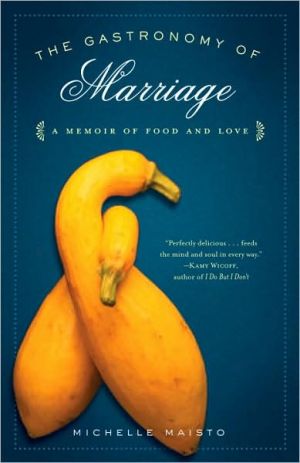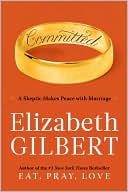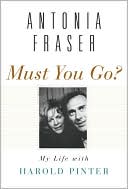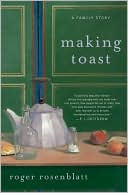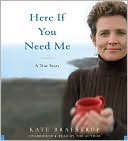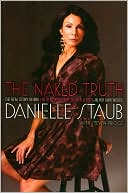The Gastronomy of Marriage: A Memoir of Food and Love
“On our first date, Rich ordered a chocolate soufflé at the beginning of the meal, noting an asterisk on the menu warning diners of the wait involved. At the time, I imagined he did it partly to impress me, which it did, though today I know well that he’s simply the type of man who knows better than to turn down a hot-from-the-oven soufflé when one is offered to him.”\ When Michelle Maisto meets Rich–like her, a closet writer with a fierce love of books and good food–their single-mindedness...
Search in google:
“On our first date, Rich ordered a chocolate soufflé at the beginning of the meal, noting an asterisk on the menu warning diners of the wait involved. At the time, I imagined he did it partly to impress me, which it did, though today I know well that he’s simply the type of man who knows better than to turn down a hot-from-the-oven soufflé when one is offered to him.”When Michelle Maisto meets Rich–like her, a closet writer with a fierce love of books and good food–their single-mindedness at the table draws them together, and meals become a stage for their long courtship. Finally engaged, they move in together, but sitting down to shared meals each night–while working at careers, trying to write, and falling into the routines that come to define a home–soon feels like something far different from their first dinner together.Who cooks, who shops, who does the dishes? Rich craves the light fare his mother learned to prepare as a girl in China, but Michelle leans toward the hearty dishes her father knew as a boy in Italy. Rich eats meat, but Michelle doesn’t. His metabolism races through carbohydrates, hers holds to them tightly. And while her idea of a quick meal is a fried egg, his is to head to a restaurant. After Rich takes additional work to pay for their wedding, Michelle offers to do his half of the cooking chores–which, along with the newness of their living together, challenges her feelings about the kitchen and what it means to be a modern wife.As they save and plan for a wedding, the nightly compromises, small generosities, and stubborn stakings of ground that take place around thedinner table offer a context in which Maisto considers what she’s learned from the marriages around her, and what she and Rich might create for themselves. Publishers Weekly First-time memoirist Maisto turns out a subtle valentine to cooking and New York City life in this chronicle of two foodies in love. Maisto is a charming writer with a keen wit and sense of setting, whether describing tennis in her beloved Brooklyn neighborhood, or reluctantly making Jell-O for her fiancé. Despite her skill, however, the book struggles to get off the ground. What momentum there is springs from Maisto's imminent nuptials, but the actual wedding ends up a side note next to the recurring question of what to make for dinner. Low-stress recipes for favorite comfort foods are scattered throughout, including her grandmother's Walnut Tarts and a dressed-up boxed chocolate cake mix recipe, each worth reading: instructions for simmering lentils include lying on the couch and "watching a television program that the person you live with, but who is not home now, thinks is stupid." Readers homesick for New York will get the most out of the book, but it's unlikely to stick out in an increasingly cluttered field of food memoirs. Copyright © Reed Business Information, a division of Reed Elsevier Inc. All rights reserved.
Chapter One\ January\ \ The first saturday of 2005 (the year of the wooden Rooster on the Chinese calendar, which is predicting a holdover of grudges) is clear and cold, with a bright, misleading sun that makes each of us anxious to get outside. Union Square is a quick three stops on the L train, so we head to the farmers’ market, where, when we manage to stay in full sun, the winter air seems not so bad.\ In the northwest corner, where Christmas trees were propped two weeks ago, plain pine wreaths are still being peddled. “Good luck to them,” Rich says quietly, echoing my thoughts. An ardent celebrator, even I have reached my tolerance for sweeping up pine needles. Rich dragged our little tree to the park a week ago, where the city was mulching them for free, and I stayed behind to sweep and vacuum, happy to reclaim those few feet of space and enjoying the pine scent coming from the warm machine.\ Today there are two farms selling apples, a woman with honey, an upstate winery pouring Riesling and ice wine, plus stands with organic beef, goat cheeses and milks, free-range eggs, and green sodlike squares of wheatgrass. A stand with glass breadboxes filled with baked goods is swarmed, but a woman selling pickles sits alone behind her table with a brave face. I feel a pang of embarrassment for her, a silly response. I can’t even bear to throw yard sales, so squeamish is my aversion to selling things—an elitist-sounding affliction, perhaps, but one likely traceable to feeling pressured to hand out religious tracts at my hometown county fair when I was twelve or thirteen, an age at which being called on in class was enough to turn me scarlet.\ The crowd is slow-moving, filled with bicycles, dogs in more fashionable coats than I own, and heavy-duty baby strollers—perfect for transporting pounds of root vegetables and tall funnels of blue-green eucalyptus, if the baby doesn’t mind. What could we do with tight, pretty Brussels sprouts, still on their stalks? It’s a vegetable I always want to like, though I still see the single sprout that my fourth-grade teacher hung in a sandwich bag from the strip of cork above the blackboard—a gift from a student, after he’d made his disdain for them known. It hung there until we left for the summer, turning every color and finally growing a soft fur. Rich likes the look of these long piled stalks as well, but it’s a relief when he suggests they might just stink up the kitchen.\ A farm from upstate is selling apples, carrots, celeriac, winter squashes, apple-cider doughnuts, and steaming cups of apple cider from immense, sticky pots. (I don’t envy whoever gets to scrub these tonight.) A long ladle goes in and we each get a cup. For a dollar more we buy a clear sandwich bag of three golden doughnuts—cake style and rolled in cinnamon and sugar—and take them into the park beside the market to share on a bench. This takes us out of the sun, but we sit close and warm our hands around our cups. A perfect Saturday.\ And still the thought comes to me: Can we stay this happy? It’s a question that I press down as quickly as it pops up. As a young girl, I would wake from naps and find my mother sitting on the carpeted steps where the sun hit during the late afternoon and nuzzle into her, still shaking off sleep. “Close your eyes,” she’d say, her face lifted to the sun, “and you can be anywhere. Where do you want to be?” Always she chose somewhere warm and far away. But Catholics didn’t divorce, and so she stayed and stayed.\ These days I find I’ve become our relationship’s barometer, its dedicated lighthouse keeper, my finger licked and lifted to every shift of mood, change of tone. The lessons my mother drilled into her daughters aren’t easy to shake. Is it possible that I’m blind and don’t know it? Could I really say “I do” and only then have the blinders fall away, revealing some terrible fate I’ve sealed myself to? A part of me continually circles back to these questions, as no-nonsense an inspection as the one I perform each morning—keys? wallet? phone?—before heading out the door, assured that the day is on track.\ Rich finishes his doughnut, switches his cider to his right hand, and puts his left arm around me, to warm and hug me closer. We’re happy, I tell myself. Things are good.\ We take a final turn around the market and pick up apples, an acorn squash, and a damp bundle of carrots with their feathery greens still attached. “How about pasta e fagioli for dinner?” I suggest, and amazingly Rich agrees. Sun or not, an hour in the cold has made us both hungry for the same type of meal. At my mother’s table, pasta e fagioli, like beef stew and minestrone, would call for buttered popovers, their hollow innards perfect for scooping up stew or wiping the dregs from a bowl. They’re easy to make, but we agree to keep things simpler still—the dirty dishes to a minimum—so while I pay for the carrots Rich maneuvers back through the crowd for a baguette from the bread stand.\ our meals are rarely transitioned into as easily as soup on a winter day. I’ve begun wondering if this is because when a person eats alone two eggs go a long way toward a respectable dinner. They’re filling, they don’t cost much, they come individually portioned, they’re actually protein (versus the cheap carbohydrates that fill most cupboards), and they aren’t much trouble to make or clean up afterward. Before we moved in together, I would happily scramble a few eggs, or make an omelet with a bit of cheese in the fold, and eat them alongside a handful of dressed salad greens, a toasted slice of good bread, and a glass of wine if there was an open bottle in the house. Or, if the greens involved frisée, I might toss them with only vinegar, salt, and pepper, poach the eggs or fry them gently, and then put them over the greens, letting their pierced yolks dribble down, acting as the dressing’s silky fat. The cheese could then go over the bread, be shown the inside of the broiler, and be eaten as a bubbly, open-faced cheese sandwich. Bliss! That all this changes once there’s a second person at the table somehow caught me by surprise.\ I used to walk from the subway back to 9J, my shared graduate-student apartment, thinking, What can I eat...\ What can I eat... Then I’d remember the eggs, the ciabatta roll left over from breakfast, that there were loose greens in the crisper, and that would be that. Forty seconds of preoccupied thought, and ten of those were imagining the rapturous moment of dipping the spongy ciabatta innards into a dripping yolk. But in the context of our new grown-up home, a dinner of eggs suddenly seems less fitting. Though even if I were up for it, the walk, the thought, the plan—all can be moot if he had eggs for breakfast; or if he’s particularly hungry and thinks this doesn’t sound filling; or even if he’s simply not in the mood. Which, honestly, is a thing I can’t argue much with. Even Elizabeth David, the author of An Omelette and a Glass of Wine, and a proponent of such a meal if ever there was one, believed that much of the pleasure of food and wine comes from “having what you want when you want it, and in the particular combination you fancy.”\ People had warned me, during those years of separate apartments: You learn new things about a person when you live together. Friends, acquaintances at parties, strangers in line at the pharmacy—with little to no provocation they had flashed this hard-won nugget at me like a badge. But at the table, Rich and I have long understood each other. We’re both game to drive all morning for a lunch of cracked crabs on newspaper, look forward to persimmon season as eagerly as to any holiday, and think trolling the aisles of foreign grocery stores is a normal part of any vacation. For my birthday our first year together, he planned the evening so that we had fresh seafood appetizers at a motorcycle bar in Malibu, and then completed the meal at a more formal restaurant down the coast. (The other part of the gift was a first-edition Márquez novel; surely cartoon hearts beat in my eyes that night.)\ And still, by August I did begin to discover things. Small things. That he likes his ketchup in the pantry, instead of in the refrigerator where I like it. That he likes cereal but not for breakfast. He likes soy milk but not in his cereal. And he likes to hurry even apples to the crisper, instead of arranging them in a pretty bowl on the counter, because he’s sure they’ll spoil instantly and attract fruit flies. The peanut butter shuttled between the baking cabinet and the refrigerator door for two weeks before the conversation was had that I prefer it chunky and cold but he likes it warm and creamy. What is the marriage protocol for such things? Were we supposed to buy both kinds, or was one of us supposed to shrug off our preference...for as long as we both shall live? The question trickled down to even the little trash can in the bathroom, which I like to eventually empty into a larger trash bag but he likes to line with a bag, most often a plastic grocery bag, that covers over the little can entirely and looks terrible. If I gave in now, could there be any reversing this later? Was I giving in forever?\ People had also insisted to me that when couples got married things changed from the way they were when they were dating. My mother frequently remarked that I should make sure I really liked Rich as a person, because all the “tingly romantic feelings” I felt now would surely someday disappear. And still others urged me forward. At the wedding of my childhood best friend (who went from single to committed, engaged, and then married through the third and fourth years of my relationship), her mother squeezed my arm and whispered, “Marriage is a good thing, just go for it!” But not one of them pointed out that there is actually no reason to expect that two people who grew up in different households, with naturally different traditions and approaches to eating and meals, and who have ethnically different versions of comfort foods, varying ideologies about what is acceptable to consume, and bodies with vastly different metabolisms and digestive traits, should easily be able to sit to the same meal each night. And yet this is what we now negotiate.\ Rich eats meat, but I don’t. My iron gut could digest a muffler, but his rebukes him for tomato sauce, carbonation, eating quickly. He prefers the light, clean flavors that his mother learned as a girl, watching the family chef in China, while I tend toward the hearty dishes of my father’s childhood in Southern Italy. And although Rich hasn’t seen the inside of a locker room since junior high, the carbohydrates in a meal of straight-up pasta bounce off him, while the moment I stop jogging they take up long-term accommodations on my hips and thighs. These details had always existed, eating in restaurants and hosting each other in our separate apartments, but six months into living together they’ve taken on new gravity. Since the moving van touched the curb, I’d been waiting for the long-promised surprise to emerge, and finally each of us could see what it was: We love to eat, and to eat together, but dinner every night, in a home of our creation, was turning out to be something else.\ To be fair, my mother did warn me, repeatedly, that marriage is all about compromise. I just never fathomed that these compromises—mature acts of finding a middle ground that as a girl I imagined myself and my perfect husband acting out with selfless patience—would happen with such frequency. And never did I imagine that the bulk of them would be over dinner.\ the carrots could do with just a good scrubbing, but I like the texture of them peeled, which takes less time anyway. The trick is to peel toward oneself, though I can’t help but like that it’s so many people’s instinct to peel away from themselves instead; it seems very survivalist, or Darwinian, that we should more naturally draw the knife away. I quarter two of the carrots lengthwise, chop them into triangles, and sauté them in olive oil with a chopped onion and two diced celery ribs. After a few minutes, I add four bulbs of minced garlic, and before it can brown I pour in vegetable stock, canned cannellini beans, the empty can’s worth of water, a squeeze of tomato paste from a tube, and a bay leaf. “Watch out for the bay leaves!” rings in my ears each time I pull one from the jar, trying to keep its brittle tip intact. My mother, endlessly terrified that one of us would choke on these dusty-looking leaves, attached an ominousness to them that it seems I may never shake.\ Once the stock is simmering and the vegetables are soft, I pull out the bay leaf, purée half the soup in the blender to make the whole thing heartier, and add a cup of cooked shell macaroni, more ground pepper, and a handful of roughly grated Pecorino. Old Italian ladies fastidiously save the heels of their hard cheeses for just such occasions, but they don’t have Rich scrubbing the bottoms of their pots after dinner and insisting, “Why can’t we just sprinkle the Parmesan over our bowls at the end? It tastes exactly the same!”\ I dress a salad of baby spinach with dried prunes and almonds, and Rich toasts slices of the baguette in the broiler—which we’ve learned to make do with, since neither of us owns a toaster—and then drizzles them with olive oil and thick kosher salt. Normally, I can’t shake the feeling that I’m still sixteen and faking my way through the adult world, but ladling up this very-not-chic favorite of grandmothers, I can’t help but feel grown-up. Rich opens a Chianti and finally we sit, say grace (or rather I do, always this falls to me) and touch glasses.\ “Buon appetito,” I say.\ “To the chef,” he answers. And we dig in.
\ From Barnes & NobleBarnes & Noble Discover Great New Writers\ The Gastronomy of Marriage: A Memoir of Food and Love For Maisto, who was raised to cook and consume hearty southern Italian food, one of the first requirements in a future husband was that he be a "good eater." So when she meets Rich and discovers that he loves food as much as she does, the table is set for a love story that, despite its ups and downs, usually finds some resolution in a yummy meal (with delicious, easy recipes that just beg to be tried).\ \ Michelle and Rich move in together, and while Rich works to save money for the wedding, Michelle does the cooking. On the cusp of her wedding, she wrestles with questions of gender stereotyping and the reality of negotiation and compromise. Her own parents divorced, so marriage looks a bit risky. Meanwhile, Rich eats meat, but Michelle doesn't. Rich favors the light, clean flavors of his Chinese heritage but can't stomach tomato sauce (of all things!). But learning how to cook and eat together merely strengthens their connection, despite their differences. \ \ In this flavorful, humorous, and uplifting examination of one woman's search to understand the ingredients for a good marriage, Maisto's voice is unfailingly honest. By the end, as the couple whips up a spontaneous dinner of antipasto, broccoli rabe, and sautéed eggplant, they find that over the recent (and difficult) months, they've learned to work together. "Not a bad team," Michelle muses. Not a bad book, either. (Holiday 2009 Selection)\ \ \ \ \ Publishers WeeklyFirst-time memoirist Maisto turns out a subtle valentine to cooking and New York City life in this chronicle of two foodies in love. Maisto is a charming writer with a keen wit and sense of setting, whether describing tennis in her beloved Brooklyn neighborhood, or reluctantly making Jell-O for her fiancé. Despite her skill, however, the book struggles to get off the ground. What momentum there is springs from Maisto's imminent nuptials, but the actual wedding ends up a side note next to the recurring question of what to make for dinner. Low-stress recipes for favorite comfort foods are scattered throughout, including her grandmother's Walnut Tarts and a dressed-up boxed chocolate cake mix recipe, each worth reading: instructions for simmering lentils include lying on the couch and "watching a television program that the person you live with, but who is not home now, thinks is stupid." Readers homesick for New York will get the most out of the book, but it's unlikely to stick out in an increasingly cluttered field of food memoirs. \ Copyright © Reed Business Information, a division of Reed Elsevier Inc. All rights reserved.\ \
